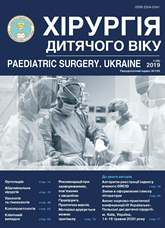Pathogenetic substantiation of minimally invasive methods of correction of heterochrony of urinary system
DOI:
https://doi.org/10.15574/PS.2019.65.48Keywords:
heterochrony, ureterohydronephrosis, stenting, ureter, children, urodynamicsAbstract
The final formation of the child’s functional systems completed during postnatal ontogeny. To create optimal conditions for the functioning of the body is necessary either to decrease the level of functional requirements to the immature system, or the creation of new operating conditions under which the extended maturation time factor. Currently, the most common treatment for obstructive uropathies is surgical treatment. A promising alternative to open surgical treatment of obstructive megaureter is endoscopic stenting of the ureter, based on an assessment of the phenomena of growth imbalances and dysfunction, tissue and maturation of the urinary system.Objective: rationale and introduction of minimally invasive endoscopic draining techniques aimed at restoring urodynamics by using a PVC intraluminal drainage (stent).
Materials and methods. The possibility of stenting with determination of the size of the mouth of the ureter was investigated. The study involved 32 children aged from birth to three years. A retrospective analysis of previously treated 41 patients with obstructive ureterohydronephrosis was performed.
Results. The study found that the optimal age for endoscopic correction of the intramural ureter is up to 3 months of life, when telescopic bougienage with dilation of the intramural compartment of the compromised ureter can be performed with calibration of the mouth and stent of the ureter with a corresponding stent.
Retrospective analysis of previously treated patients allowed us to determine the same dependence. Thus, out of 41 patients with obstructive ureterohydronephrosis positive result was achieved in 29 children (70.73%) up to 1 year and 6 (14.63%) over 1 year. The impossibility of performing endoscopic correction of the orifice and stenting of the ureters in the age group up to 1 year was noted only in 1 patient (2.43%), whereas in the group from 1 year to 3 years – in 5 patients (12.19%).
Conclusions. The proposed tactics of treatment of obstructive uropathy in children has advantages in terms of open surgical techniques in the technical simplicity, minimally invasive, maximum physiological, reducing the incidence of postoperative complications. It should be remembered that the effectiveness of endoscopic stenting of the lower parts of the ureter depends on the age of the child.
The research was carried out in accordance with the principles of the Helsinki Declaration. The study protocol was approved by the Local Ethics Committee of participating institution. The informed consent of the patient was obtained for conducting the studies.
References
Akilov HA, Hakkulov EB. (2015). Treatment of Ureterohydronephrosis in Association with Ureterocele in Children. Bulletin of problems biology and medicine. 1(122); 3: 75-78. http://nbuv.gov.ua/UJRN/Vpbm_2015_3(1)__17
Buchmin AV, Rossikhin VV, Krivoshej AV, Turenko IA. (2016). Phenotypic manifestations of tissue dysplasia with dysmetabolic nephropathy and chronic pyelonephritis in children. Urologiya, andrologiya, nefrologiya. Proceedings of the Scientific and Practical Conference. Kharkіv: 34-36.
Dmitryakov VA, Svekatun VN, Stoyan MS et al. (2017). Pathogenetic substantiation of minimally invasive methods of urinary system heterochrony correction. Zaporozhye Medical Journal. 4: 436-440. https://doi.org/10.14739/2310-1210
Dmytriakov VA, Svekatun VM, Stoyan MS, Kornienko HV. (2018). Selective-segmental resection of the kidney as an alternative to nephrectomy in children with hydronephrosis. Sovremennaya Pediatriya. 2(90): 26-30. https://doi.org/10.15574/SP.2018.90.26
Dmitryakov VA, Stoyan MS, Svekatun VN et al. (2016). Endoscopic treatment of hydronephrosis in children. Urologiya, andrologiya, nefrologiya – 2016. Proceedings of the Scientific and Practical Conference. Kharkiv: 186-187.
Zhuravlev VN, Bazhenov IV, Istoksky KN et al. (2013). Clinical rehabilitation of patients after retroperitoneoscopic operation on vesicoureteral segment. Ural Medical Journal. 9(114): 34-40. eLIBRARY ID: 21057011
Lukianenko NS, Kens KA, Petritsa NA, Koroliak OYa. (2015). Congenital malformations of the urinary system in infants and syndrome of undifferentiated tissue dysplasia. Pochki. 1(11): 12–17. eLIBRARY ID: 23591424. https://doi.org/10.22141/2307-1257.0.1.11.2015.75392
Menovschikova LB, Levitskaya MV, Gurevich AI et al. (2015). Lowinvasive method for treatment of infantile nonreflexing megaureter. Perm Medical Journal. 32;2: 19-24. eLIBRARY ID: 23498948
Peterburgskyy VF, Golovkevich VV, Guyvan GI. (2013). The echographic markers of urodynamics decompensation in nonrefluxing megaureters in infants. Urolohiia. 3(66): 11-13. eLIBRARY ID: 25676068
Salnikov VY, Gubarev VI, Zorkin SN et al. (2016). High-pressure endoscopic balloon dilatation as the method of primary obstructive megaureter treatment in children. Pediatria. Journal named after GN Speransky. 95;5: 48-52. eLIBRARY ID: 26685007
Strizhakovskaya LO, Khmara TV. (2013). Modern Information about Congenital Malformations of the urether. Vestnik problem biologii I mediciny. 1;2(99): 35-39. eLIBRARY ID: 19421860
Goldsmith Z, Oredein-McCoy O, Gerber L et al. (2013). Emergent ureteric stent vs percutaneous nephrostomy for obstructive urolithiasis with sepsis: patterns of use and outcomes from a 15-year experience. BJU International. 112(2): E122–E128. https://doi.org/10.1111/bju.12161; PMid:23795789
Parente A, Angulo J, Romero R et al. (2013). Management of Ureteropelvic Junction Obstruction With High-pressure Balloon Dilatation: Long-term Outcome in 50 Children Under 18 Months of Age. Urology. 82(5): 1138-1144. https://doi.org/10.1016/j.urology.2013.04.072; PMid:23992967
Sertic M, Amaral J, Parra D et al. (2014). Image-Guided Pediatric Ureteric Stent Insertions: An 11-Year Experience. Journal of Vascular and Interventional Radiology. 25(8): 1265-1271. https://doi.org/10.1016/j.jvir.2014.03.028; PMid:24837979
Downloads
Issue
Section
License
The policy of the Journal “PAEDIATRIC SURGERY. UKRAINE” is compatible with the vast majority of funders' of open access and self-archiving policies. The journal provides immediate open access route being convinced that everyone – not only scientists - can benefit from research results, and publishes articles exclusively under open access distribution, with a Creative Commons Attribution-Noncommercial 4.0 international license(СС BY-NC).
Authors transfer the copyright to the Journal “PAEDIATRIC SURGERY.UKRAINE” when the manuscript is accepted for publication. Authors declare that this manuscript has not been published nor is under simultaneous consideration for publication elsewhere. After publication, the articles become freely available on-line to the public.
Readers have the right to use, distribute, and reproduce articles in any medium, provided the articles and the journal are properly cited.
The use of published materials for commercial purposes is strongly prohibited.

